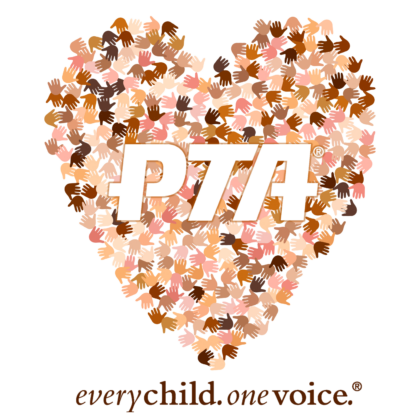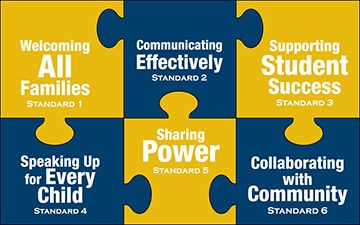 We all know that families come in many shapes and sizes. Some families are large, with lots of children. Some are small. Some families have one parent, some have several parents. Some families are headed by grandparents or foster parents, two moms, two dads. Some families have welcomed adopted children or foster children in addition to or instead of children born into them. Regardless of the “shape” of a family in a school or district, strong PTAs embrace the role that a student’s family plays in supporting that student’s education.
We all know that families come in many shapes and sizes. Some families are large, with lots of children. Some are small. Some families have one parent, some have several parents. Some families are headed by grandparents or foster parents, two moms, two dads. Some families have welcomed adopted children or foster children in addition to or instead of children born into them. Regardless of the “shape” of a family in a school or district, strong PTAs embrace the role that a student’s family plays in supporting that student’s education.
According to the Global Family Research Project: “More than 50 years of research tells us that family engagement is one of the most powerful predictors of children’s development, educational attainment, and success in school and life. If we hope to move the needle on greater educational equity and social justice, we must empower families to support their children’s learning and ensure that all families and communities have what it takes to build equitable learning pathways for children.”
Knowing the power of family engagement as a positive force for student education outcomes, National PTA has provided resources to help us to develop successful school-family partnerships. Family Engagement Standard #1 tells us that, “Families are active participants in the life of the school, and feel welcomed, valued, and connected to each other, to school staff, and to what students are learning and doing in class.” Our PTAs can ask some critical questions to think about the environment their school provides in welcoming families to the educational space:
- When families walk into the building, do they feel the school is inviting and is a place where they “belong”?
- Do the school’s policies and programs reflect, respect, and value the diversity of the families in the community?
 National PTA’s rubric for reviewing your PTA’s answers to these questions can help you think about how best to engage your families in the programs offered through your PTA, and how to engage in their student’s education.
National PTA’s rubric for reviewing your PTA’s answers to these questions can help you think about how best to engage your families in the programs offered through your PTA, and how to engage in their student’s education.
Keep in mind that many of your families starting school this Fall may never have set foot in your school. With the shift to remote learning during the pandemic, families new to your school or new to school, in general, will need extra support as they transition to in-person learning this year. How will your PTA provide a welcoming and supportive community for these and all families?
Think about the first experience families will have when they step onto school grounds. What does the signage look like? Are multiple languages represented in support materials? If your PTA has a bulletin board or other display, will families of all shapes and sizes see themselves in that display as an important part of their student’s education? How will you welcome them to your PTA as a valued voice in serving the students in their families and in the school? How will you invite them to participate as a volunteer or member of your PTA?
 This is the perfect time of year to plan for ways that your PTA will welcome all families. Consider ways that your PTA can support the first days of school, especially for families that may be new to the school or new to in-person learning at the school. And don’t leave out those families who will be continuing remote learning this Fall. Those families could be especially at risk for feeling left out as many of their student’s friends and classmates may be returning to in-person learning.
This is the perfect time of year to plan for ways that your PTA will welcome all families. Consider ways that your PTA can support the first days of school, especially for families that may be new to the school or new to in-person learning at the school. And don’t leave out those families who will be continuing remote learning this Fall. Those families could be especially at risk for feeling left out as many of their student’s friends and classmates may be returning to in-person learning.
If your PTA or school doesn’t already have something similar to a family resource center, consider setting one up that provides answers to common questions in multiple languages. This can be an in-person or virtual “booth” at a back-to-school event or a more permanent presence in a main office or commons. This can even be a virtual Q and A session. Don’t make this the place to sell spirit gear or sign people up to volunteer. Provide a service to families by answering questions about things like:
- How to plan for lunches or bus routes
- How to volunteer in classrooms
- How to have a productive conversation with a teacher
- How to view grades online
- How to meet with a school counselor
If you can do so, be sure to staff your family resource center with people who can answer questions in multiple languages. Above all, be sure that you have worked with school staff to ensure that the answers you provide are accurate and consistent with the answers the staff would provide.
This year is going to be a challenge for us all. Being a welcoming source of support and information for your families – no matter the family’s composition – will aid in supporting students. It will also be a way to strengthen your school community. And we have never needed communities more than we do now. Let’s be there for families and their students. Let’s be the change.
Resources:
National PTA’s Family Engagement Standard #1 Rubric (https://www.pta.org/docs/default-source/files/programs/national-standards-for-family-school-partnerships/assessment_guide_standard_1.pdf)
Global Family Research Project (https://globalfrp.org/)
Guest post provided by WSPTA FACE Director Shelby Reynolds